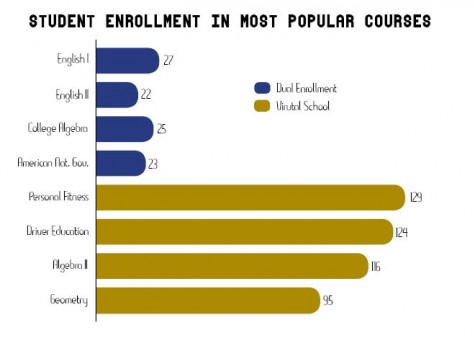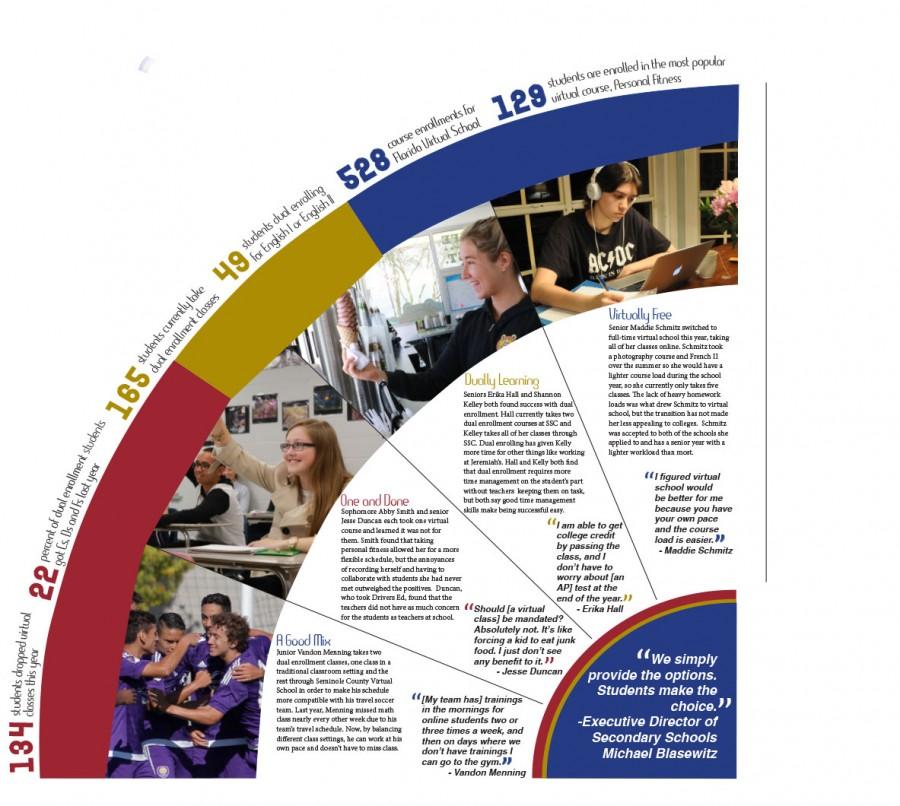The choice is yours: Alternative Education
photo by Jeannie Williams and Madeline Kemper
Your schedule is yours. The responsibility is yours. The outcome, more than ever, is yours, and it seems as though sitting in school for a full day is rarely the option chosen.
According to Dr. Michael Blasewitz, the Executive Director of Secondary Schools, alternative education has grown as students want to have more input in creating their school day.
“Students should select the model that works best for them and yields the best academic results,” Blasewitz said.
Virtual school, which can be taken through Seminole County Virtual School or Florida Virtual School, is the most popular alternative education option. The Florida Department of Education mandates students are required to take one virtual course throughout their high school career.
“Virtual has skyrocketed, and it really helps students have flexibility in their schedule,” guidance counselor Joan Toro said.
Another main reason to take virtual school is so that students can get ahead. No set pace or class time means that students can get ahead. No set pace or class time means that students can fit in extra classes into already busy schedules.
“Our student population is very high achieving,” guidance counselor Erin Issacs said. “We are, next to Crooms, the top high school in Seminole County.”
At the end of her freshman year, sophomore Chloe Macfarlane decided to use virtual school to graduate in three years.
“Creating your own schedule for assignments really forces you to become independent, motivated and very organized,” Macfarlane said.
She has taken eight virtual school classes so far, and by the time she graduates will have taken 11.

“I’ve created a lot of great experiences and memories at Hagerty by being very involved and making friends,” Macfarlane said. “I’m doing everything a typical high school student does, just in three years.”
One downside, however, is that Macfarlane will not be able to continue as the class president, which she has done for the past two years.
The other popular option is dual enrollment, which is when classes that count toward graduation are taken at the collegiate level, either through Seminole State College or the University of Central Florida for Seminole County. This option is less popular due to the requirements students must meet to dual enroll. Students must show they are college ready by testing proficiently in the SAT, ACT or PERT.
Dual enrollment courses, however, can be hard to compare, because there are no national standards.
“Put it this way: AP classes are standard, national, all-across-the-board,” guidance counselor Erin Isaacs said. “Dual enrollment is school-by-school, so the standards are not necessarily the same.”
College Board statistics boast that AP students who scored a three or higher on at least one AP exam had more positive college outcomes than students who dual enrolled.
The bottom line for admissions directors is seeing success in the courses students choose.
”We look at all accelerated mechanisms equally in the admission review process and prefer to see A’s in all courses attempted,” UCF Admissions Director Gordon Chavis said.
Despite this, guidance leans away from dual enrollment.
“What I say to students is that if you think it’s easier and other students think [dual enrollment is] easier, what do you think that colleges think?” Toro said.
One of the biggest perks of dual enrollment is being on a college campus.
Other students take classes to save money and so they only have to go to the class two or three times a week instead of every day.
“I do have an advantage, mostly for schedule reasons, but when it comes down to it, I don’t have any more of an advantage than students who take many AP classes,” senior Natalie Rivera said.
For students such as Rivera, who is currently in four dual enrollment classes, the schedule allows them to take on a heavier work schedule.
She also participates in On-the-Job Training which allows for students to leave campus to go to a job and have hours scheduled during the day.
“My job is only open during daytime hours, and it would be impossible for me to ever be scheduled if I weren’t dual enrolling and in OJT,” Rivera said.
But with dual enrollment students take a risk.
“Last year, 22 percent of our kids had Cs, Ds and Fs in dual enrollment,” Toro said. “There are very bright kids, all taking dual enrollment, and yet, almost a quarter of them did not do very well.”
Just meeting dual enrollment requirements does not guarantee success in courses.
Another rare option for students is doing fulltime dual enrollment their senior year, known as early enrollment.
“Where I have seen [early enrollment] as an issue is [when students] feel like they are not linked to Hagerty anymore,” Toro said. “They feel like they grew up too fast and didn’t have a senior year.”
This was true for SSC student Shannon Kelly, who would have been a senior this year, but instead became classified as an early college student and will have her associate’s degree by the end of the spring semester.
“I went to two football games, but they weren’t the same as they had been in previous years, and I haven’t decided if I am going to prom.” Kelly said. “I have been in the past and I think that was enough for me.”
Kelly, however, does not regret her decision and would advise students to dual enroll for the flexibility in schedule and money that students can save.
“I decided to do this because I felt that going to high school was a waste of time,” Kelly said. “You spend the whole day there five days a week killing yourself with AP classes and the pressure to get in to college and then you graduate with hardly more than a pat on the back.”
The many forms of hybrid scheduling have allowed for students to create a schedule that fits them best and allows them to be successful.
“We simply provide the options,” Blasewitz said. “Students make the choice.”
Your donation will support the student journalists of Hagerty High School. We are an ad-free publication, and your contribution helps us publish six issues of the BluePrint and cover our annual website hosting costs. Thank you so much!







